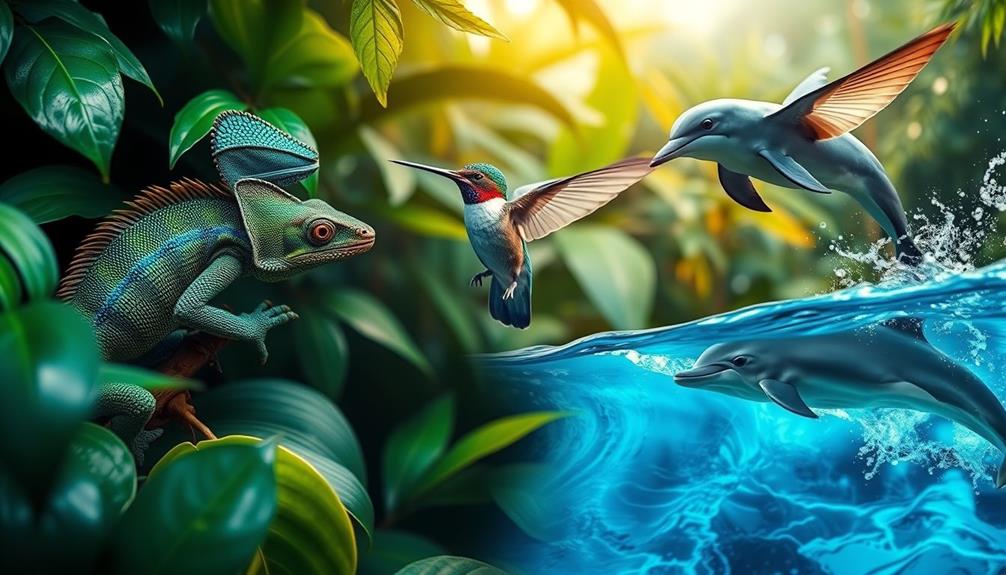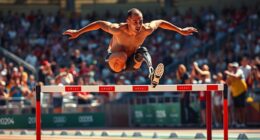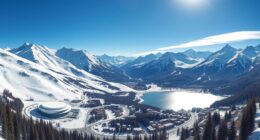When you explore the animal kingdom, you'll discover astonishing abilities that feel like superpowers. Imagine the wood frog surviving being frozen solid or the tardigrade thriving in extreme environments. Marvel at the axolotl, which regenerates limbs effortlessly. You could be amazed by the strength of the Hercules beetle, lifting over 850 times its weight. Feel the thrill of the peregrine falcon, the fastest bird, soaring at 240 mph. Each of these traits highlights the ingenuity of nature. Keep going to uncover even more jaw-dropping examples of animal abilities that push the limits of what you thought was possible.
Key Takeaways
- The Axolotl can regenerate limbs, spinal cords, and even parts of its brain, showcasing remarkable healing abilities akin to superhero powers.
- Tardigrades can survive extreme conditions, including the vacuum of space and temperatures from -272°C to 150°C, highlighting their resilience.
- The Peregrine Falcon is the fastest bird, reaching speeds over 240 mph, demonstrating extraordinary agility in the animal kingdom.
- Electric Eels generate shocks up to 860 volts, using electric communication and hunting techniques that resemble superhuman abilities.
- The Immortal Jellyfish can revert to its juvenile form, defying death and showcasing an extraordinary life cycle that seems almost mythical.
Extreme Survival Adaptations
Extreme survival adaptations showcase nature's incredible ingenuity in helping creatures endure harsh conditions.
Take the Wood Frog, for instance. You'd be amazed to learn that it can survive being frozen solid during winter. Its body water turns to ice, but the cell liquids remain viscous, allowing it to spring back to life within 30 minutes of thawing.
Curiously, the phenomenon of sonoluminescence secrets also demonstrates nature's ability to create extraordinary effects under specific conditions, much like the adaptations seen in these remarkable animals.
Then there are tardigrades, or water bears, who've mastered the ability to change their state to survive extreme temperatures from -272°C to 150°C. They can even endure the vacuum of space by entering a cryptobiotic state, surviving desiccation for decades.
Naked mole rats present another fascinating example. They thrive in low-oxygen environments and show remarkable resilience to cancer, showcasing unique adaptations that contribute to their long lifespan.
Incredible Regenerative Powers
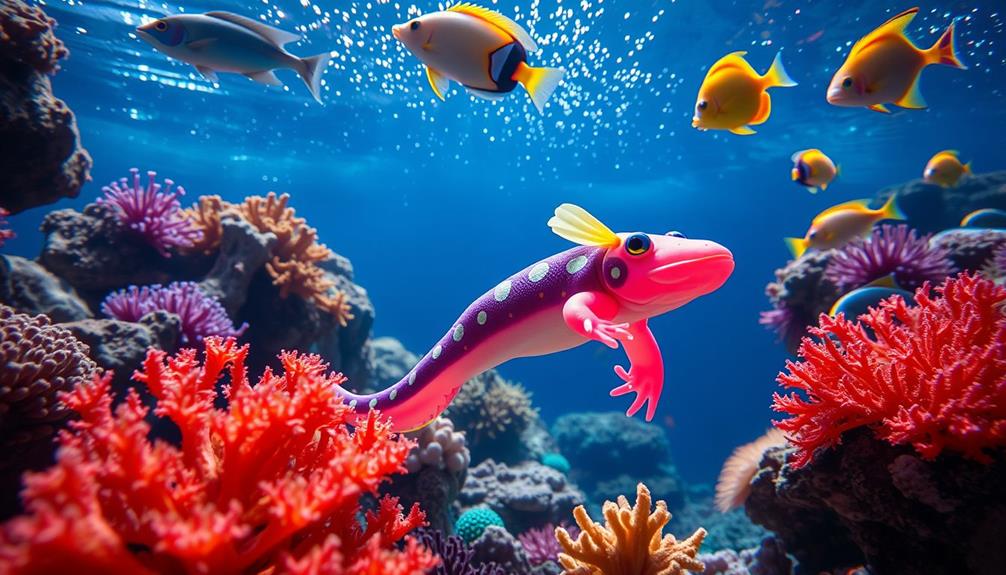
Many creatures possess extraordinary regenerative abilities that enable them to recover from injuries and even restore lost body parts.
Take the axolotl, for instance. This remarkable amphibian showcases incredible abilities by regenerating limbs, spinal cords, hearts, and even parts of its brain. Scientists are fascinated by its regenerative capabilities, hoping to reveal secrets that could aid human medicine, similar to the intense emotional experiences seen in BPD-coded characters.
Planarians also impress with their unique talent; they can regrow entire bodies from tiny fragments. Each piece develops into a complete worm while retaining learned behaviors from the original organism.
Then there's the Immortal Jellyfish (*Turritopsis dohrnii*), which can revert to its juvenile form after maturing, effectively cheating death through a process called transdifferentiation.
Salamanders are another example, able to regenerate limbs, tails, and parts of their hearts, making them one of the most proficient regenerators among vertebrates.
Finally, starfish can regrow lost arms and internal organs, with some species capable of regenerating their entire bodies from a single arm.
These incredible abilities highlight nature's ingenuity, leaving you in awe of the regenerative capabilities some creatures possess.
Unmatched Strength in Nature
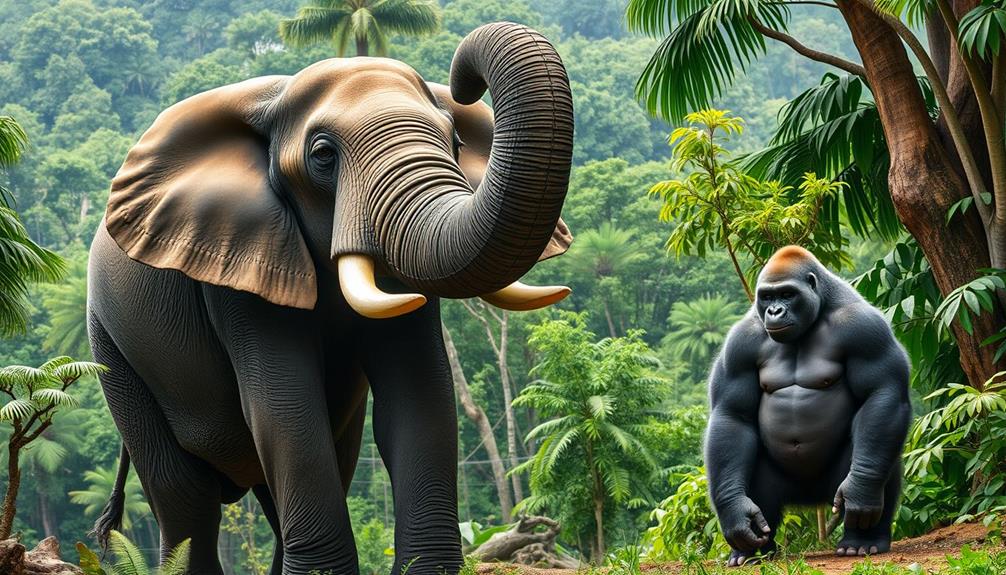
When you think about strength in the animal kingdom, the numbers can be mind-blowing. For instance, the Hercules beetle can lift over 850 times its weight, while the horned dung beetle pulls an astonishing 1,140 times its body weight.
These examples show just how incredible lifting capacity and weight-pulling abilities can be in nature. Similarly, dogs also exhibit remarkable strength relative to their size, especially breeds like the Australian Shepherd, which excel in agility and obedience.
Understanding dog nutrition and health is essential for maintaining their physical prowess and overall well-being.
Incredible Lifting Capacity
Nature's strongest creatures exhibit incredible lifting capacities that often defy our expectations.
Take the Hercules beetle, for instance, which can lift over 850 times its body weight. Imagine a human lifting a small car! Then, there's the Horned Dung Beetle, holding the record for the strongest animal relative to its size, capable of pulling 1,140 times its weight. These tiny champions of strength showcase super strength that's hard to fathom.
Curiously, just like choosing the right tools for a job, selecting the best sprayer is essential for achieving ideal results in painting projects, as some models handle thicker materials better than others choosing the right sprayer.
But it doesn't stop there. The diabolical ironclad beetle can support an astonishing 39,000 times its body weight, thanks to its exceptionally strong exoskeleton.
Moving up the scale, grizzly bears exhibit incredible lifting capacity too, able to hoist over 1,000 pounds (450 kg). Such power is impressive and highlights the diverse strengths in the animal kingdom.
African elephants further demonstrate unmatched lifting capacity among land animals, effortlessly moving logs weighing several tons.
Clearly, these creatures redefine our understanding of strength, proving that in nature, size doesn't always dictate power. When it comes to lifting, they truly are nature's heavyweights.
Extreme Weight-Pulling Abilities
While lifting capacity showcases impressive strength, extreme weight-pulling abilities take that power to another level. In the animal kingdom, some creatures exhibit mind-blowing feats of strength relative to their size. Consider the horned dung beetle, which can pull over 1,140 times its body weight! This tiny titan demonstrates how extreme weight-pulling abilities can astound us.
Here's a table to visualize these remarkable strengths:
| Animal | Weight-Pulling Ability | Remarkable Fact |
|---|---|---|
| Horned Dung Beetle | 1,140 times its weight | Strongest relative to size |
| Hercules Beetle | 850 times its weight | One of the most powerful insects |
| Diabolical Ironclad Beetle | Withstands 39,000 times force | Unique exoskeleton structure |
| Grizzly Bear | Over 1,000 pounds (450 kg) | Incredible strength among mammals |
| African Elephant | Moves several tons | Uses strength for social interactions |
These examples highlight the astonishing capacities of various species, showcasing that extreme weight-pulling abilities aren't just for show—they're essential for survival, foraging, and social behaviors in the wild.
Unbelievable Strength Comparisons
Showcasing the remarkable strength found in nature reveals astonishing comparisons that can leave you in awe. Take the Hercules Beetle, for instance. This tiny powerhouse can lift over 850 times its own body weight, making it one of the strongest insects on the planet.
Evaluating Bitcoin IRA Suitability highlights how even tiny creatures can demonstrate extraordinary capabilities against their size. Then there's the Horned Dung Beetle, which can pull objects more than 1,140 times its body weight, showcasing incredible fortitude in such a small form.
But it doesn't stop there. The Diabolical Ironclad Beetle can withstand crushing forces of 39,000 times its body weight, thanks to its unique exoskeleton structure.
When you switch focus to terrestrial mammals, the Grizzly Bear demonstrates immense physical strength, capable of lifting over 1,000 pounds (450 kg).
Even more astonishing, Rhinoceros Beetles can create strength comparable to a human lifting a car.
These comparisons illustrate just how diverse and extraordinary strength can be across species. Whether it's an insect or a massive bear, nature's unmatched strength serves as a reminder of the incredible capabilities that exist all around us.
Unique Hunting Strategies
When you think about unique hunting strategies, consider the archerfish, which expertly shoots water to snag insects from branches.
Then there's the octopus, using its incredible ability to blend into its environment for stealthy attacks.
And let's not forget the cuttlefish, which changes colors to confuse prey and enhance its hunting success.
Archerfish Water Shooting Precision
Archerfish are fascinating creatures known for their incredible water shooting precision, making them skilled hunters in their Southeast Asian habitats. They possess a remarkable ability to shoot jets of water with pinpoint accuracy, striking insects resting above the water's surface from distances of up to 6.5 feet. This unique hunting strategy hinges on their specialized mouth structure, which creates a powerful water jet through a unique groove, allowing them to aim effectively.
Notably, just like how cats exhibit signs of attachment, archerfish also demonstrate strong survival instincts that contribute to their hunting prowess.
One of the most impressive aspects of archerfish is their adaptability of life in freshwater environments. They can adjust for light refraction, compensating for the bending of light as it passes from air to water. This skill enables them to hit their targets with greater success.
Studies have shown that their water jets are strong enough to knock prey into the water, showcasing their proficiency as hunters.
In a world where survival depends on skill, the archerfish's precision and adaptability set them apart from other species. Their ability to combine physical features with environmental awareness exemplifies nature's ingenuity, making them a true marvel of the animal kingdom.
Octopus Camouflage and Intelligence
The octopus stands out in the animal kingdom with its remarkable ability to camouflage and its impressive intelligence, both of which play an essential role in its unique hunting strategies.
Using specialized skin cells called chromatophores, the octopus can change its skin color and texture in seconds, allowing it to blend seamlessly into its surroundings. This camouflage not only aids in evading predators but also helps in ambushing prey.
Curiously, these skills can be likened to the meticulous preparation methods emphasized in basic herbal preparation methods, showcasing how both creatures and herbalists utilize their environment effectively.
Moreover, the octopus showcases advanced problem-solving skills and navigates complex environments with ease, demonstrating its high levels of intelligence.
Some species, like the mimic octopus, take this a step further by impersonating other marine animals, such as lionfish and flatfish, to deceive both predators and prey.
In addition to these tactics, the octopus can expel ink to create a smokescreen, offering a quick escape from threats.
It also displays cognitive abilities by using tools like coconut shells and rocks for shelter or protection.
Cuttlefish Color Change Tactics
In the depths of the ocean, cuttlefish employ their remarkable color-changing abilities as unique hunting strategies that set them apart from other marine creatures. With specialized skin cells called chromatophores, they can change color and texture in seconds. This ability to mimic their surroundings allows them to blend seamlessly into their environment, making them expert ambush hunters.
Such adaptations are a demonstration of the importance of play in the natural world, as observing and interacting with their environment enhances their cognitive skills and problem-solving abilities, similar to how play-based learning enhances retention in children.
When you observe a cuttlefish, you'll notice it can create a wide variety of intricate patterns and displays. These patterns not only serve for camouflage but also facilitate communication with other cuttlefish during mating or territorial disputes.
Their advanced vision enhances this skill, enabling them to detect polarized light and perceive contrasts in their habitat.
In addition to evading predators, cuttlefish use their color-changing tactics to distract potential prey. By shifting colors and patterns, they can get closer to unsuspecting targets, often going undetected until it's too late.
Their intelligence further complements their hunting strategies, as they exhibit problem-solving skills that allow them to manipulate visual cues in their environment, proving that these creatures are truly masters of deception in the aquatic domain.
Exceptional Sensory Perception

Many animals possess extraordinary sensory abilities that far surpass human capabilities. Take the mantis shrimp, for instance. With 16 color receptors, these creatures enjoy exceptional sensory perception, allowing them to see a dazzling array of colors, including ultraviolet light. This ability not only enhances their hunting skills but also aids in communication with fellow shrimp.
Notably, just as some investors explore diversification of retirement portfolio through unique assets, these animals leverage their sensory skills to thrive in their environments.
Then there are dogs, whose sense of smell is 10,000 to 100,000 times more acute than yours. Imagine tracking scents and trails with such precision!
Bats also boast enviable sensory skills, using echolocation to navigate and hunt in complete darkness. By emitting high-frequency sounds and interpreting the echoes, they can pinpoint prey and obstacles effortlessly.
Honeybees add to this list, as they can perceive ultraviolet light, helping them identify flowers for nectar and playing a significant role in pollination.
Finally, elephants utilize infrasound to communicate over long distances, enabling them to detect vibrations and sounds that you can't even perceive.
These animals with enviable sensory abilities remind us just how diverse and remarkable the animal kingdom truly is.
Mastery of Camouflage

When you think about how animals survive in the wild, their mastery of camouflage stands out. Some, like cuttlefish, can change their color and texture in the blink of an eye, while others, like the mimic octopus, imitate the appearance of dangerous creatures to evade threats.
This incredible ability not only helps them hide but also enhances their chances of finding food and mating.
Curiously, similar principles apply to foraging practices, where understanding the environment and utilizing essential foraging techniques can lead to discovering hidden edible treasures in nature.
Color Change Mechanisms
While some animals rely on physical barriers for protection, others master the art of camouflage through remarkable color change mechanisms. These abilities not only help them evade predators but also facilitate communication and hunting.
Here are a few fascinating examples:
- Cuttlefish use chromatophores, specialized skin cells that allow them to expand or contract pigments, creating rapid color changes.
- Octopuses combine chromatophores with iridophores to alter both color and texture, enabling them to blend seamlessly into their environment.
- Chameleons adjust their skin's chromatophores based on light, temperature, and even emotions, showcasing their unique color-changing prowess.
- The mimic octopus goes a step further, imitating the appearance and behavior of toxic marine animals like lionfish to ward off threats.
These color change mechanisms highlight the incredible adaptability of these creatures, showcasing their evolutionary skills.
Whether it's a cuttlefish changing its hue in an instant or a chameleon shifting colors to match its surroundings, these animals remind us that nature's artistry often seems like pure magic.
Imitation for Survival
Camouflage isn't just about changing color; it's about mastering imitation to survive. Take the Mimic Octopus, for example. This remarkable creature can mimic various toxic sea creatures like lionfish and flatfish, using its impressive skill to deter predators. It's like having superpowers in the underwater world!
Then there's the cuttlefish, which boasts specialized skin cells called chromatophores. These allow it to change color and texture almost instantly, enhancing its ability to blend in and communicate effectively.
Chameleons are famous for their color-changing abilities, seamlessly blending into their surroundings to evade threats and ambush prey.
Leaf-tailed geckos take disguise to extraordinary levels, resembling leaves or twigs to escape detection in their forest habitats.
Meanwhile, lyrebirds showcase their auditory mastery, mimicking a range of natural and artificial sounds—from chainsaws to camera shutters—to attract mates and communicate with others.
In nature, these creatures exemplify how imitation is a powerful survival tool. Their ability to mimic not only keeps them safe but also enhances their chances of thriving in their environments.
Electric Communication Abilities

Electric communication abilities in electric eels showcase the fascinating ways these creatures interact with their environment. These remarkable fish generate electric shocks of up to 860 volts, not just for hunting but also for social interactions. By utilizing specialized electric organs, electric eels can produce various electrical discharges that serve different purposes.
- Low-voltage signals for navigation and communication
- High-voltage shocks to incapacitate prey
- Burst discharges for stunning fish
- Territorial establishment and mate attraction through electric signals
Electric communication is essential for these eels, allowing them to establish territory and connect with potential mates. The low-voltage signals help them navigate murky waters while ensuring they communicate effectively with one another.
When it comes to hunting, the high-voltage electric shocks are a game-changer, incapacitating fish and other small aquatic organisms with ease.
Found primarily in the Amazon and Orinoco river basins, electric eels aren't only fascinating creatures but also subjects of research for advancements in bioelectricity and its potential technological applications. Their unique abilities are a reflection of the wonders of nature.
Speed and Agility Champions

When it comes to speed and agility, few animals can compete with the Peregrine Falcon, which reaches astonishing speeds over 240 mph.
You'll be amazed by the Cheetah's ability to sprint at 75 mph, covering incredible distances in just seconds.
And don't underestimate the Mantis Shrimp, whose punch accelerates faster than a bullet, showcasing the power of speed in the animal kingdom.
Peregrine Falcon Speed Mastery
The peregrine falcon, a true marvel of nature, dominates the skies with its astonishing speed and agility. As the fastest bird in the world, it can reach mind-boggling speeds over 240 mph (386 km/h) during its hunting stoop. This incredible ability not only makes it a fascinating animal but also a masterful predator.
- Specialized wing shape enhances aerodynamics.
- Powerful muscles enable rapid acceleration.
- Keen eyesight allows for precise prey detection.
- Adaptable to various environments across the globe.
When you observe a peregrine falcon, you're witnessing a perfect blend of strength and precision. Its unique wing structure and muscle composition facilitate swift maneuvers, allowing it to dive through the air with unmatched grace.
As it spots potential prey from great distances, the falcon initiates its high-speed pursuit, often catching its meal mid-flight.
This extraordinary ability to combine speed, agility, and keen vision places the peregrine falcon at the top of the avian food chain, showcasing how nature equips animals with the tools they need to thrive in their environments.
Mantis Shrimp Punch Power
Speed and agility aren't just the domain of birds like the peregrine falcon; the mantis shrimp takes rapid strikes to a whole new level. This remarkable creature can deliver a punch that accelerates at a staggering 50 mph, making it one of the fastest strikes in the animal kingdom.
Imagine the force generated by this punch—comparable to that of a .22 caliber bullet! It's powerful enough to break aquarium glass and crack the shells of its prey.
Equipped with specialized appendages called raptorial claws, the mantis shrimp doesn't just strike; it captures prey with incredible precision. When it punches, it creates cavitation bubbles that collapse with a loud pop, producing shockwaves capable of stunning or even killing nearby prey.
But the mantis shrimp's superpowers don't stop there. Its advanced eyesight, featuring 16 color receptors, allows it to detect a stunning array of colors and polarized light, enhancing its hunting prowess.
With such extraordinary abilities, the mantis shrimp truly embodies the ultimate combination of speed, agility, and power in the underwater world.
Cheetah's Sprinting Prowess
Cheetahs' incredible sprinting prowess makes them stand out as the fastest land animals on the planet. Reaching speeds of up to 75 mph (120 km/h) in short bursts, these agile creatures are built for life on the move. Their lightweight body and unique adaptations allow them to accelerate from 0 to 60 mph in just 3 seconds—faster than most sports cars!
- Their flexible spine extends stride length during sprints.
- Non-retractable claws offer better ground traction.
- Specialized foot pads improve grip for quick turns.
- They rely on explosive sprints to hunt prey like gazelles.
A cheetah's body is a marvel of evolution, designed to dominate the open grasslands where they thrive.
When you watch them sprint, it's like witnessing a living embodiment of speed and agility; they epitomize the essence of life in the wild. This remarkable ability isn't just about raw speed; it's a finely-tuned balance of power, precision, and purpose.
The next time you think of superpowers, remember the cheetah, a true champion of speed, showing us what it means to be at the pinnacle of animal abilities.
Remarkable Bioluminescence
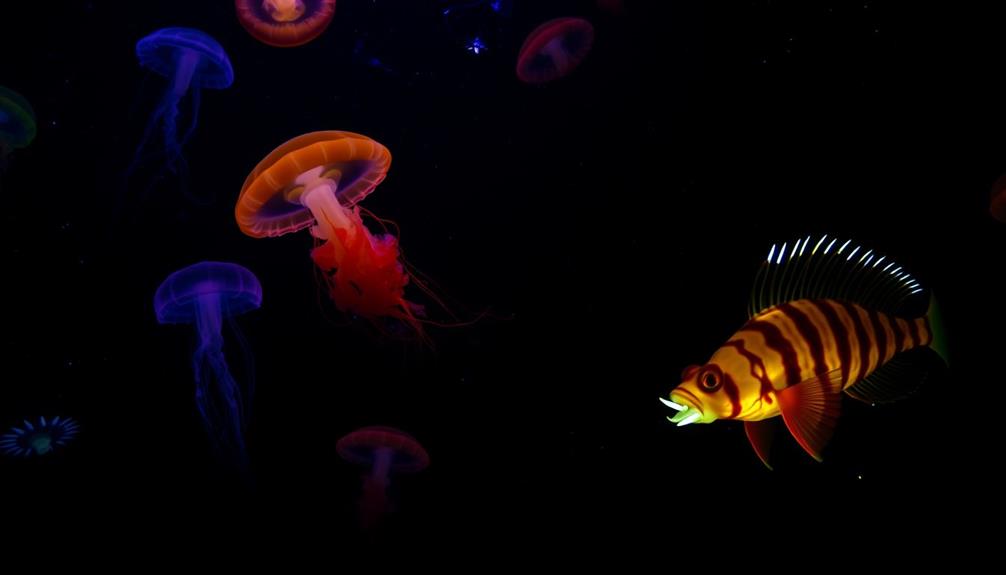
Illuminating the depths of our oceans and forests, bioluminescence captivates with its mesmerizing glow. This natural phenomenon occurs when certain organisms produce light through biochemical reactions. Over 700 known species exhibit this remarkable ability, primarily in marine environments. Bioluminescence serves various purposes that enhance survival in dark habitats, from attracting mates to luring prey.
Take the anglerfish, for instance. Its glowing lure draws unsuspecting prey closer, making it an effective predator. In contrast, fireflies, those enchanting terrestrial insects, utilize bioluminescence to communicate. They produce distinct light patterns to attract mates, creating a magical dance of illumination on warm summer nights.
But bioluminescence isn't limited to the depths of the ocean or the skies. Some fungi, like "foxfire" mushrooms, glow in the dark, casting an ethereal light in forested areas.
This enchanting phenomenon not only captures our imagination but also highlights nature's incredible adaptability. As you explore the wonders of bioluminescent organisms, you'll find that these glowing marvels reveal a fascinating aspect of life on Earth, proving that nature often holds secrets that seem like superpowers.
Extraordinary Mimicry Skills
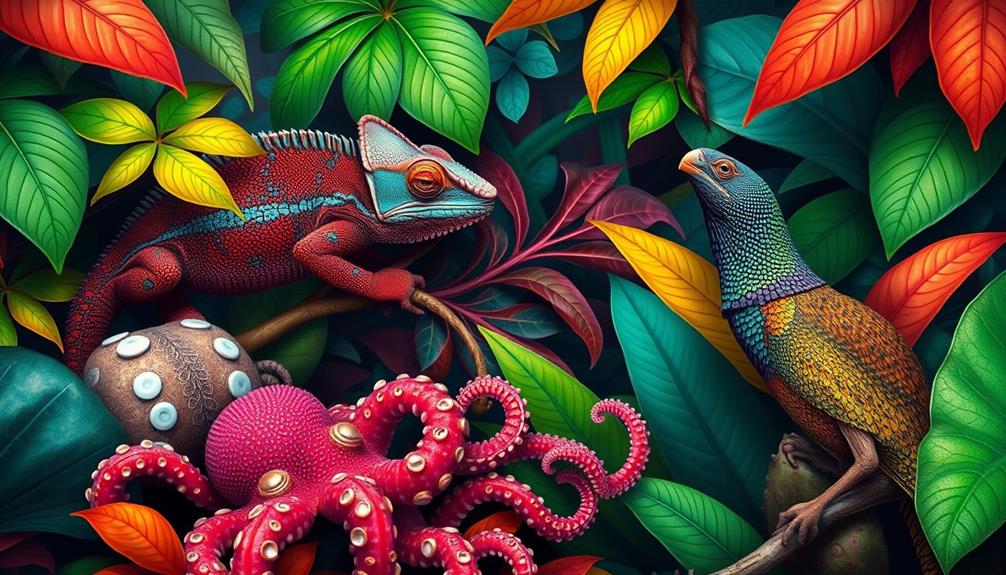
Countless creatures in the animal kingdom possess extraordinary mimicry skills that allow them to adapt and thrive in their environments.
These super animals can disguise themselves, communicate, or evade predators in remarkable ways. Here are some fascinating examples:
- The Mimic Octopus can impersonate various marine animals like lionfish and sea snakes, altering its color and shape to evade threats.
- Lyrebirds mimic a wide range of sounds, from other birds' songs to human-made noises, demonstrating exceptional auditory skills.
- Cuttlefish utilize chromatophores to change their skin color and texture in seconds, effectively blending into their surroundings or signaling to other cuttlefish.
- The Hawk Moth mimics the sound of a hummingbird, allowing it to approach flowers undetected while feeding on nectar.
These extraordinary mimicry skills not only showcase the adaptability of these animals but also highlight the intricate relationships they maintain within their ecosystems.
By blending in or mimicking others, these super animals enhance their survival chances in a world filled with challenges.
The art of disguise in the animal kingdom is as enchanting as it's essential.
Resilience Against Toxins
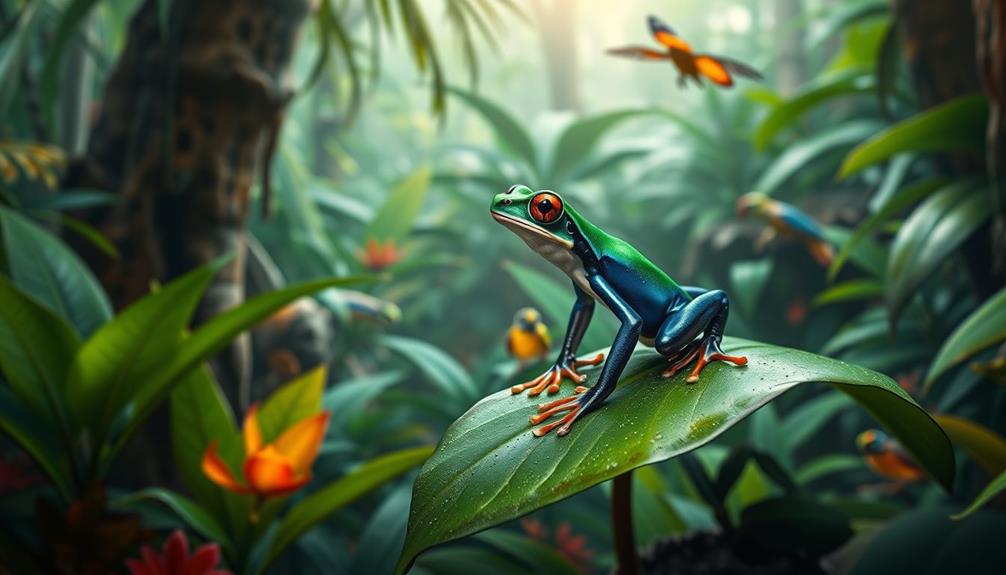
In the wild, some animals have developed remarkable resilience against toxins that would incapacitate or kill others. Take vultures, for example. Their highly acidic stomachs allow them to consume decaying carcasses, neutralizing harmful bacteria like anthrax and botulism that would pose a risk to most creatures.
Poison dart frogs, on the other hand, secrete potent toxins through their skin, deterring predators with their vibrant colors, effectively using these toxins as a defense mechanism.
Honey badgers showcase incredible resilience against snake venom, thanks to their thick skin and quick recovery from bites that would be fatal to other mammals.
Similarly, Eastern indigo snakes display resistance to the venom of rattlesnakes, allowing them to hunt these dangerous reptiles without succumbing to their toxins.
Even pufferfish possess a unique adaptation: they contain tetrodotoxin, a potent neurotoxin, which they can store and produce without harming themselves.
These astonishing abilities highlight the remarkable resilience against toxins found in various species, turning what could be a death sentence into a survival strategy.
In their own ways, these animals demonstrate nature's ingenuity in overcoming toxic threats.
Adaptations for Oxygen Deficiency
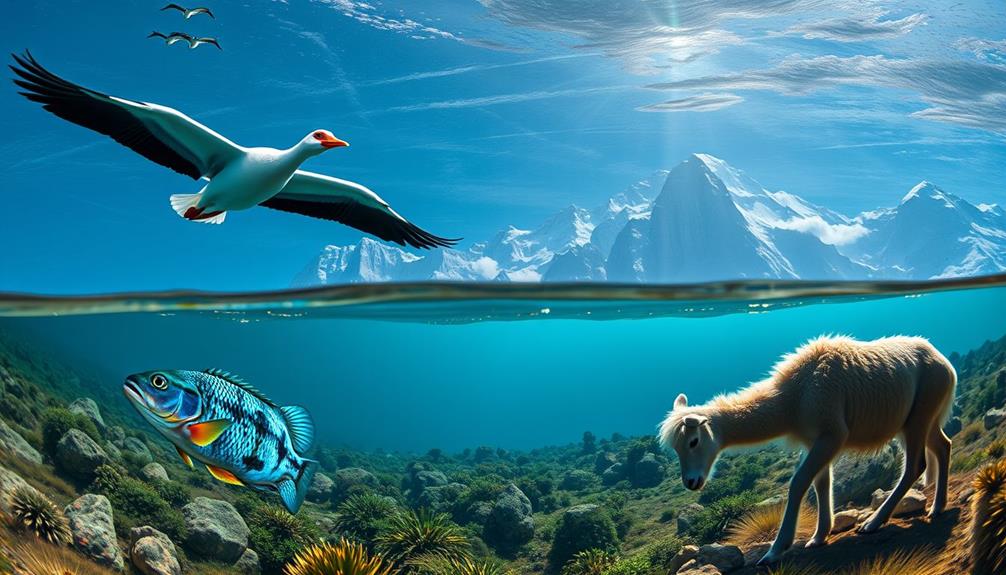
Many remarkable animals have evolved unique adaptations that allow them to thrive in oxygen-deficient environments. These adaptations showcase the incredible ways life can persist even in the harshest conditions. Here are some notable examples:
- Naked Mole Rat: Uses fructose for energy, enabling survival in low-oxygen underground colonies.
- Loricifera: This tiny marine invertebrate lives deep in the ocean, thriving in anoxic environments over 3,000 meters.
- Henneguya salminicola: One of the first known anaerobic animals, it lacks mitochondria, showing how life can exist without traditional cellular respiration.
- Goldfish: These fish can switch to anaerobic metabolism during hypoxic conditions, allowing them to survive longer without oxygen.
Certain turtle species, like the Soochow Softshell Turtle, demonstrate adaptations for anaerobic respiration, enabling them to endure extended periods submerged in muddy environments.
Additionally, some organisms enter a state of cryptobiosis, effectively suspending their metabolic processes until conditions improve.
These adaptations highlight the incredible resilience of life and its ability to adapt to extreme environmental challenges, proving that even in the absence of oxygen, survival is possible.
Unique Reproductive Traits
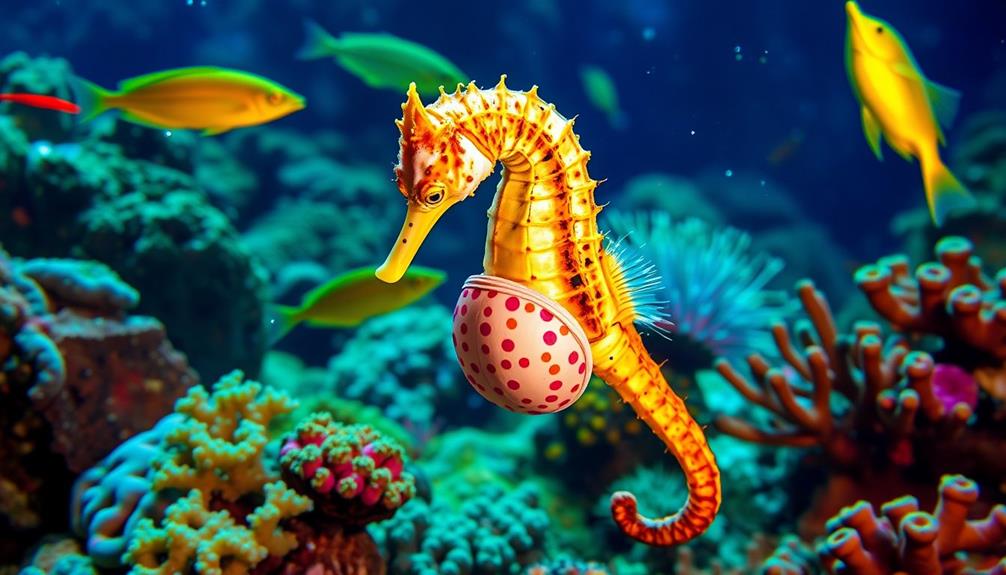
Life's adaptability extends beyond survival in harsh environments; it also manifests in fascinating reproductive strategies among various species. These unique reproductive traits not only guarantee the continuation of their kind but also showcase the incredible diversity of life.
Here's a look at some remarkable examples:
| Animal | Unique Trait | Fun Fact |
|---|---|---|
| Platypus | Male platypuses possess venomous spurs for defense during mating. | They're the only venomous mammals! |
| Seahorse | Male seahorses carry fertilized eggs in a pouch. | This is a rare instance of male pregnancy. |
| Honeybee | The queen can lay up to 2,000 eggs daily. | This maintains the hive's population. |
| Clownfish | They can change gender if the dominant female dies. | This guarantees reproductive continuity. |
These reproductive adaptations highlight the creative ways animals solve challenges related to reproduction. From the venomous male platypus ensuring their rivals stay away, to seahorses nurturing their young, nature proves that there's no one-size-fits-all approach to continuing a species.
Unyielding Endurance
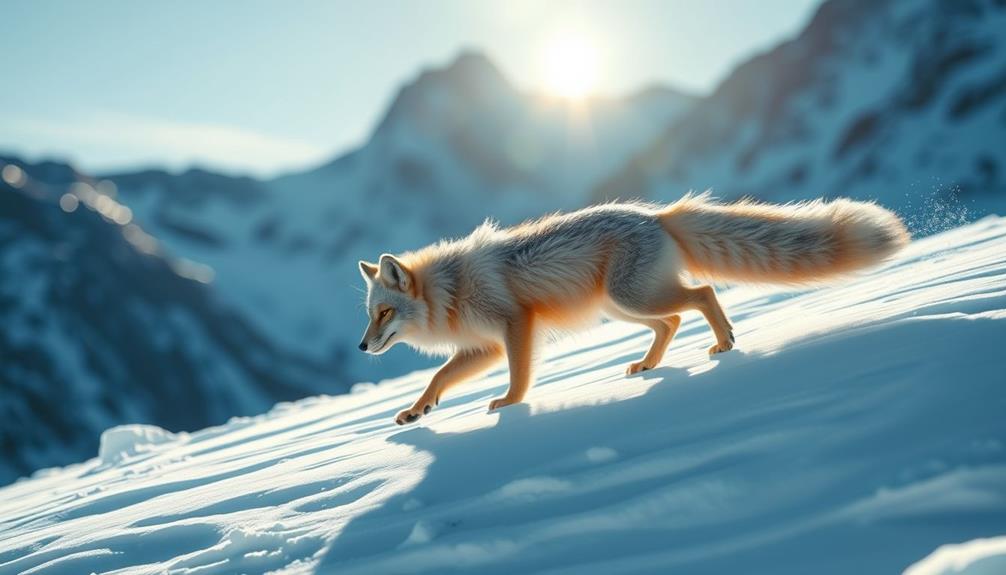
Unyielding endurance is a remarkable trait found in various species, showcasing nature's ability to adapt to extreme conditions. The true superpowers of these creatures highlight their resilience and survival instincts. Here are some fascinating examples:
- Tardigrades can withstand temperatures from -272°C to 150°C and endure radiation levels 1,000 times higher than humans.
- Wood frogs survive being frozen solid, resuming normal functions within 30 minutes of thawing.
- Naked mole rats thrive in low-oxygen environments, thanks to unique metabolic adaptations and cancer resistance.
- Immortal jellyfish can revert to a juvenile state, effectively bypassing death and restarting their life cycle indefinitely.
These animals exhibit an unyielding endurance that defies our understanding of life's limits. Their extraordinary capabilities inspire awe and curiosity, pushing you to reconsider the boundaries of survival.
Whether it's a tardigrade entering a cryptobiotic state or a wood frog defying winter's chill, these creatures prove that life finds a way, even in the harshest environments. Embracing their tenacity helps you appreciate the wonders of evolution and the incredible diversity of life on our planet.
Uncommon Defense Mechanisms

In the animal kingdom, survival often hinges on the ability to fend off predators, and many creatures have evolved remarkable defense mechanisms to do just that.
Take the Bombardier Beetle, for instance. It has an uncanny ability to eject a boiling-hot, noxious chemical spray from its abdomen, deterring any would-be attackers.
Similarly, the Pufferfish inflates its body and showcases sharp spines, while housing potent toxins that can be lethal to predators.
Then there's the Hairy Frog, which employs a gruesome yet effective defense mechanism by breaking its own toe bones to create sharp claws. This unconventional tactic helps it fend off threats.
Sea Cucumbers, on the other hand, eject their internal organs to confuse predators, allowing them time to escape and regenerate those lost parts later.
Lastly, the Skunk emits a foul-smelling spray that can reach up to 10 feet away, using chemicals that induce irritation and nausea in potential threats.
Each of these animals showcases an extraordinary approach to survival, demonstrating that in the wild, the most unusual defense mechanisms can be the most effective.
Conclusion
As you've discovered, the animal kingdom is filled with astonishing abilities that challenge our understanding of biology. Some scientists theorize that these superpowers evolved as survival mechanisms in harsh environments, hinting at nature's incredible adaptability. Imagine what other hidden talents creatures might possess, waiting to be uncovered! By appreciating these extraordinary traits, you not only gain insight into the complexities of life but also inspire curiosity about the wonders still left to explore in the wild.
